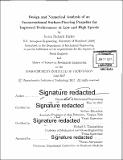Design and numerical analysis of an unconventional surface-piercing propeller for improved performance at low and high speeds
Author(s)
Parker, Justin Richard
DownloadFull printable version (13.48Mb)
Other Contributors
Massachusetts Institute of Technology. Department of Mechanical Engineering.
Advisor
Stefano Brizzolara and Michael S. Triantafyllou.
Terms of use
Metadata
Show full item recordAbstract
Traditional propellers operate fully submerged, with cavitation limited as much as possible in order to minimize its disruptive and damaging consequences. Conversely, supercavitating propellers operate in an encompassing vapor cavity, thereby averting these negative effects while substantially reducing drag on the blades. Surface-piercing propellers, operating under a similar concept as supercavitation, often achieve even greater efficiency by drawing in an air cavity from the free surface. Existing small craft have demonstrated the ability of such propellers to yield extremely high speeds (110+ knots); nevertheless, the full potential of these propellers has yet to be explored. In particular, designs often neglect low-speed performance, focusing solely on high-speed operation. This research therefore developed a new surface-piercing propeller concept designed instead to maximize performance across the spectrum of operating speeds. Applying established theory for supercavitating hydrofoils, the new blades were shaped based on theoretical maximally-efficient two-dimensional profile sections. Furthermore, in order to affect the low-speed performance enhancement, the trailing edge of each profile was appended with a unique "tail" form that allows the blade to resemble a traditional propeller when operating at subcavitating speeds without sacrificing supercavitating performance. The design used an existing racing propeller as a baseline for comparison, matching certain characteristics (rotational speed, advance speed, number of blades, hub size) in order to ensure equivalent operating conditions. Computational fluid dynamics (CFD) of the 2D profiles informed changes to the profile shapes until lift-to-drag (L/D) was maximized while ensuring a fully-encompassing vapor cavity. The complete propeller was drafted from these optimized radial sections for full 3D CFD analysis. Results from both the 2D and 3D CFD simulations revealed promising benefits to propulsive efficiency. High-speed performance met or exceeded that of the baseline propeller, and low-speed performance showed significant improvement. This surface-piercing propeller concept offers an unconventional design with convincing results for balanced low- and high-speed operation.
Description
Thesis: Nav. E., Massachusetts Institute of Technology, Department of Mechanical Engineering, 2017. Thesis: S.M., Massachusetts Institute of Technology, Department of Mechanical Engineering, 2017. Cataloged from PDF version of thesis. Includes bibliographical references (pages 95-98).
Date issued
2017Department
Massachusetts Institute of Technology. Department of Mechanical EngineeringPublisher
Massachusetts Institute of Technology
Keywords
Mechanical Engineering.